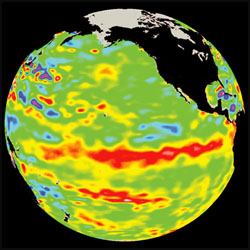|
El Nino effect
It leads to bad weather
 Do
you know what an El Nino effect is? You must have heard this word while
listening to the weather forecast. Sometimes, when we get a period of
bad weather, the Meteorology Department says that it is because of the
El Nino effect. Today, we'll see what this El Nino effect actually is. Do
you know what an El Nino effect is? You must have heard this word while
listening to the weather forecast. Sometimes, when we get a period of
bad weather, the Meteorology Department says that it is because of the
El Nino effect. Today, we'll see what this El Nino effect actually is.
An El Nino is a temporary change in the climate of the Pacific Ocean,
in the region around the equator. You can see its effects in both the
ocean and atmosphere. Typically, the ocean surface warms up by a few
degrees Celsius. At the same time, the place where heavy thunderstorms
occur on the equator moves eastward. Although they may seem like small
differences, they nevertheless can have big effects on the world's
climate.
Now, let's see what causes the El Nino. Usually, the wind blows
strongly from east to west along the equator in the Pacific area. This
actually piles up water (about half a metre in height) in the western
part of the Pacific.
In the eastern part, deeper water (which is colder than the
sun-warmed surface water) gets pulled up from below to replace the water pushed west. So, the normal situation is that
of warm water (about 30 degrees Celsius) in the west and cold water
(about 22 degrees Celsius) in the east.
below to replace the water pushed west. So, the normal situation is that
of warm water (about 30 degrees Celsius) in the west and cold water
(about 22 degrees Celsius) in the east.
In an El Nino, the winds pushing the water around get weaker. As a
result, some of the warm water piled up in the west slumps back down to
the east, while cold water in lesser quantities gets pulled up from
below. Both these tend to make the water in the eastern Pacific warmer,
which is one of the characteristics of an El Nino.
But it doesn't stop there. The warmer ocean then affects the winds;
it makes the winds weaker! So, when the winds get weaker, the ocean gets
warmer, which makes the winds even weaker, which in turn makes the ocean
even warmer. This is called a positive feedback, and is what makes an El
Nino grow.
What do you think helps prevent an El Nino from growing? The ocean is
full of waves, but you might not know how many different kinds of waves
there are. One called the Rossby wave is quite unlike the waves you see
when you visit the beach. It's more like a distant cousin of a tidal
wave.
The difference is that a tidal wave moves very quickly, with all the
water moving pretty much in the same direction. In a Rossby wave, the
upper part of the ocean, say the top 100 metres or so, will be leisurely
sliding one way, while the lower part, starting at 100 metres and going
down, will be slowly moving the other way.
After a while, they switch directions. Everything happens very slowly
and inside the ocean, and you can't see anything happening on the
surface. They are rather slow and can take months or even years to cross
the oceans.
Even if you had the patience to sit and wait while one was passing
by, you'd hardly notice it; the water would be
 moving
100 times slower than the walking speed. But they are large, hundreds or
thousands of kilometres in length (not height! Remember, you can hardly
see them on the surface), so they can have an effect on their
surroundings. moving
100 times slower than the walking speed. But they are large, hundreds or
thousands of kilometres in length (not height! Remember, you can hardly
see them on the surface), so they can have an effect on their
surroundings.
Another wave you rarely hear about is called a Kelvin wave, and it
has some characteristics in common with Rossby waves, but is somewhat
faster and can only exist close to the equator (say, within about five
degrees of latitude around the equator). El Nino often starts with a
Kelvin wave propagating (spreading) from the western Pacific over
towards South America.
When an El Nino gets going in the middle or eastern part of the
Pacific, it creates Rossby waves that drift slowly towards Southeast
Asia. After several months of travelling, they finally move near the
coast and get reflected.
The changes in interior ocean temperature that these waves carry with
them "cancel out" the original temperature changes that led to the El
Nino in the first place. The main point is that it shuts off when these
funny interior-ocean waves travel all the way over to the coast of Asia,
get reflected, and travel back; a process that can take many months.
A strong El Nino is often associated with wet winters over the
south-eastern US, as well as drought in Indonesia and Australia. You may
not always find these effects even though there is an El Nino going on;
but an El Nino make these effects more likely to happen.
A strong El Nino can last a year or more before conditions return to
normal. It happens quite irregularly. On average, complex computer
models designed to predict El Nino can successfully do so 12 to 18
months in advance.
However, it seems to vary by episode. Sometimes, an El Nino could be
predicted quite accurately, with plenty of advance notice, while at
other times, they are predicted poorly, with the equipment not picking
them up until the El Nino has already started.
Compiled by Janani Amarasekara |
